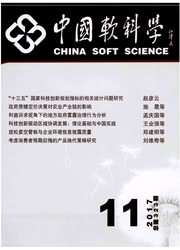

 中文摘要:
中文摘要:
本文首先运用SBM方向性距离函数和Luenberger生产率指数对考虑“坏”产出的中国工业绿色生产率及其来源进行了测算,进而分析了费用型环境规制和投资型环境规制对中国工业绿色增长产生的不同影响。基于1999—2012年中国省际面板数据的实证研究结果表明:1中国工业绿色生产率年均增长3.04%,技术进步是其增长的主要来源;2费用型规制与工业绿色生产率之间呈“U”型关系,而投资型规制与工业绿色生产率之间具有负向线性关系,表明“强波特假说”成立与否,不仅与环境规制的强度密切相关,也取决于环境规制的类型;3费用型规制与投资型规制在促进工业绿色生产率提升方面存在互补关系,意味着多样化环境规制组合使用的重要性。本文的研究结论不仅验证并完善了“波特假说”理论,同时对中国环境规制的创新及规制工具的选择具有指导意义。
 英文摘要:
英文摘要:
This paper applies SBM directional distance function and Luenberger productivity index to measure ' green' total factor productivity (ETFP) growth and its components of China' s industry while accounting for energy consumption and undesirable output. Then we divide environmental regulation into two types, that is, environmental expenditure and environmental investment, and empirically examine how the two types of regulation impact the ETFP growth differently employing panel data of China' s 30 provinces during the period of 2000 to 2012. The results show that the ETFP of industry has an average annual growth rate of 3.04% and technical progress is the main source. The results of empirical analysis indicate that the relationship between environmental expenditure and ETFP is U-shaped, while environmental investment has a linear and negative impact on ETFP. It implies that the prerequisites of Porter Hypothesis relate not only to the stringency of environmental regulation, but also to the types. Furthermore, there is a complementary relationship between the two types of regulation which implies the importance of policy combination. Finally, this paper provides some policy recommendations which have certain practical significance for ' green' productivity growth and reform of environmental regulation system of China.
 同期刊论文项目
同期刊论文项目
 同项目期刊论文
同项目期刊论文
 期刊信息
期刊信息
